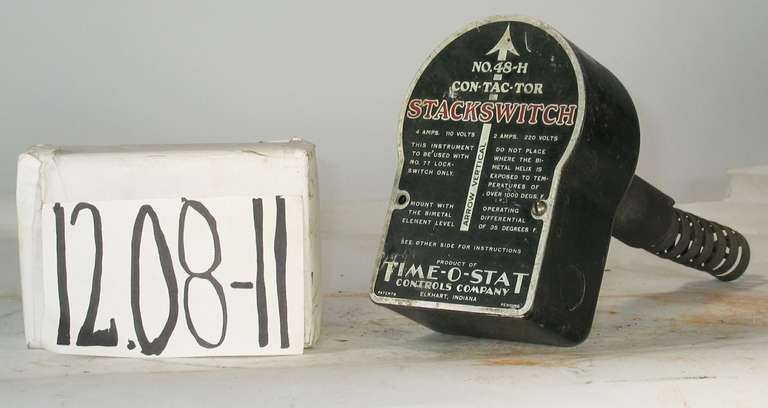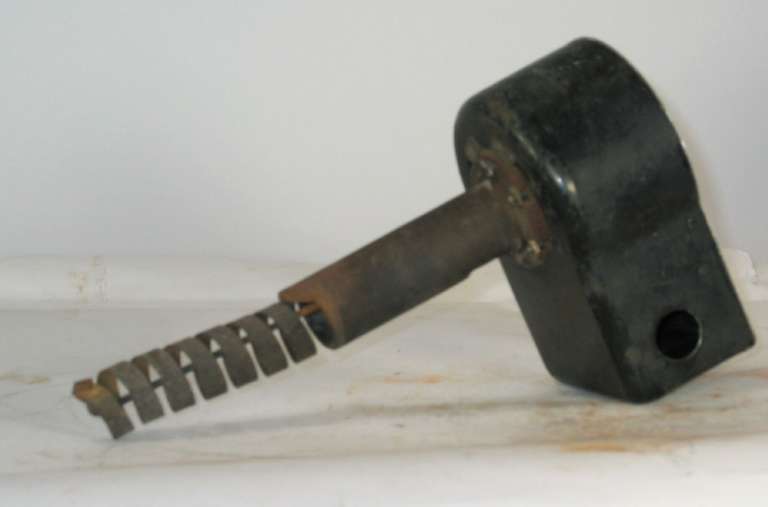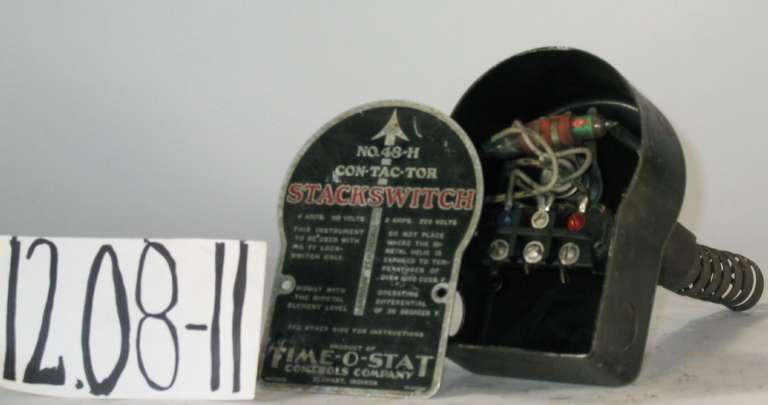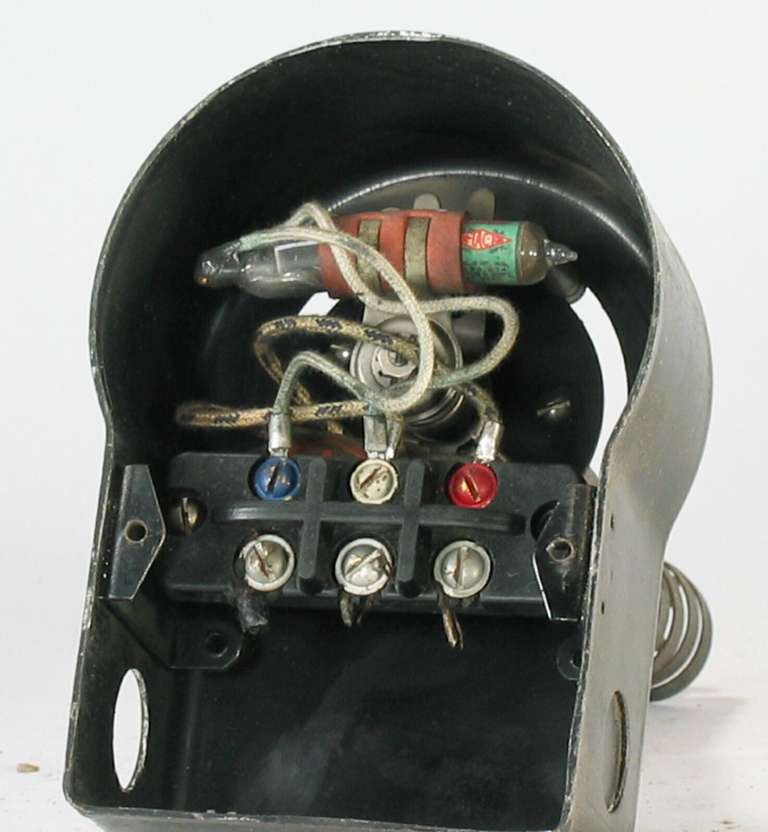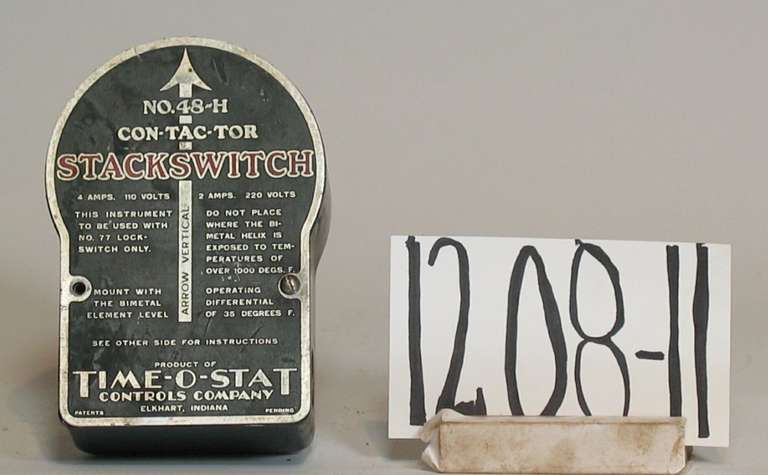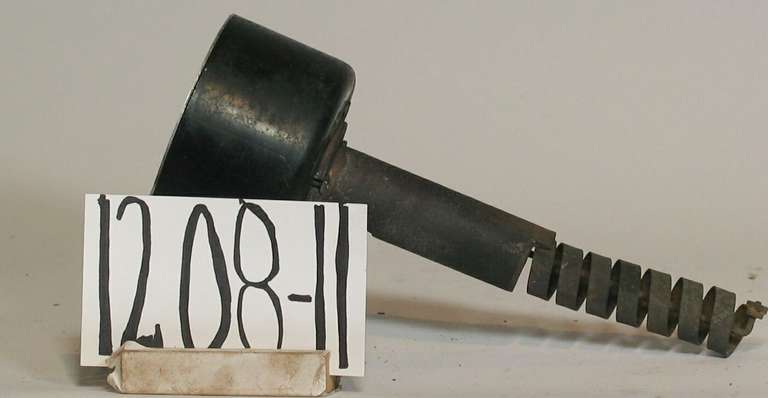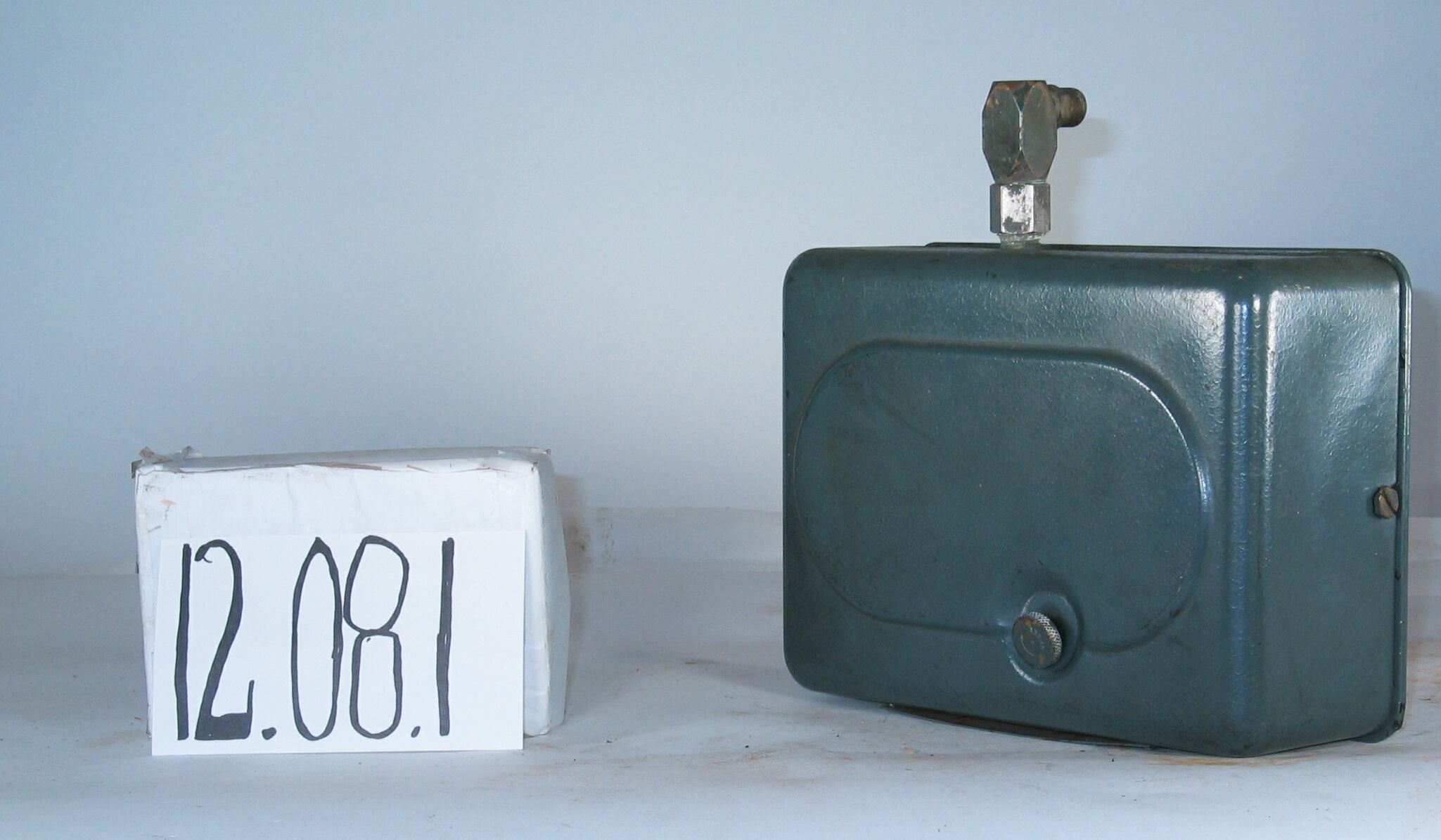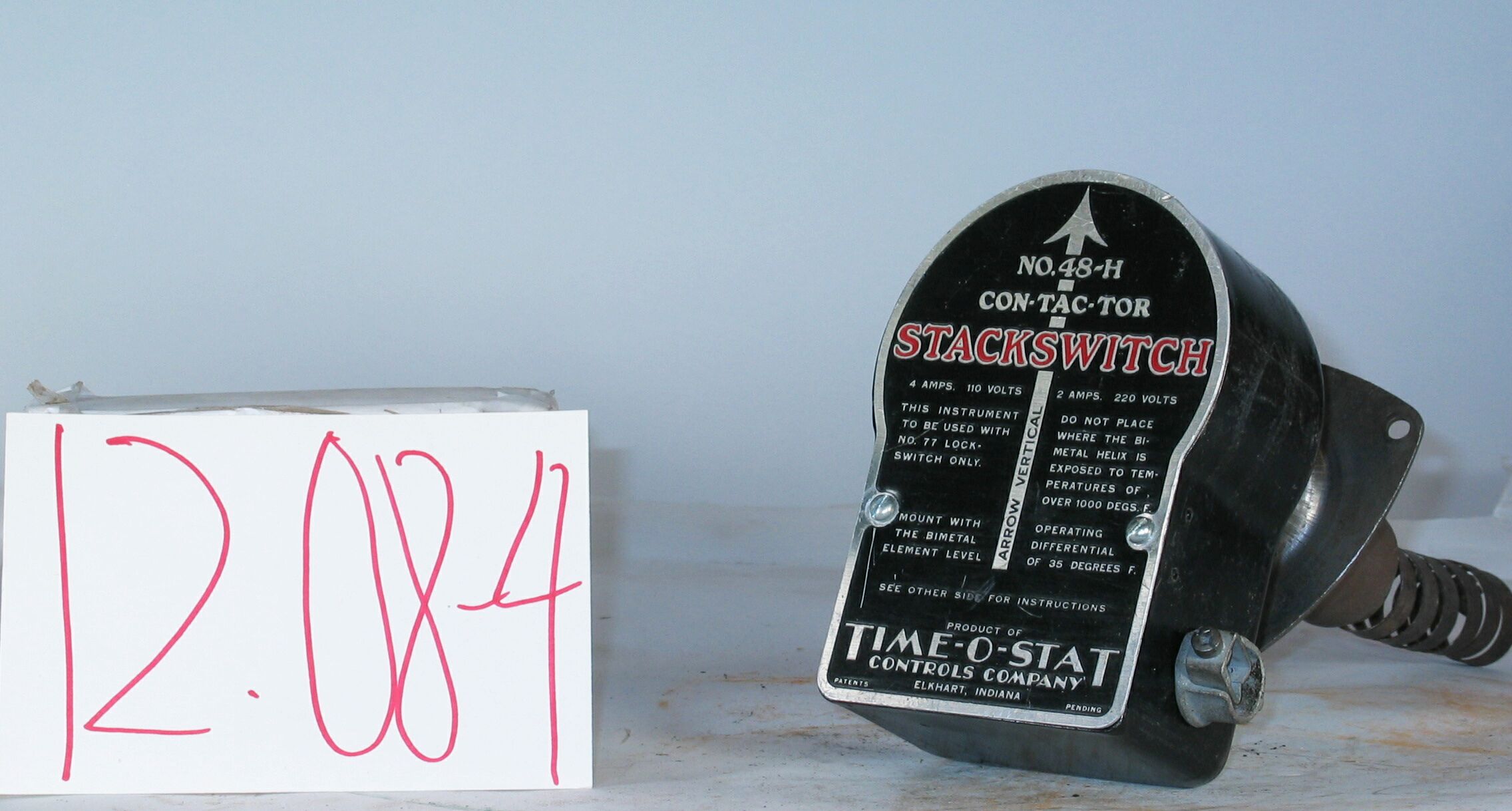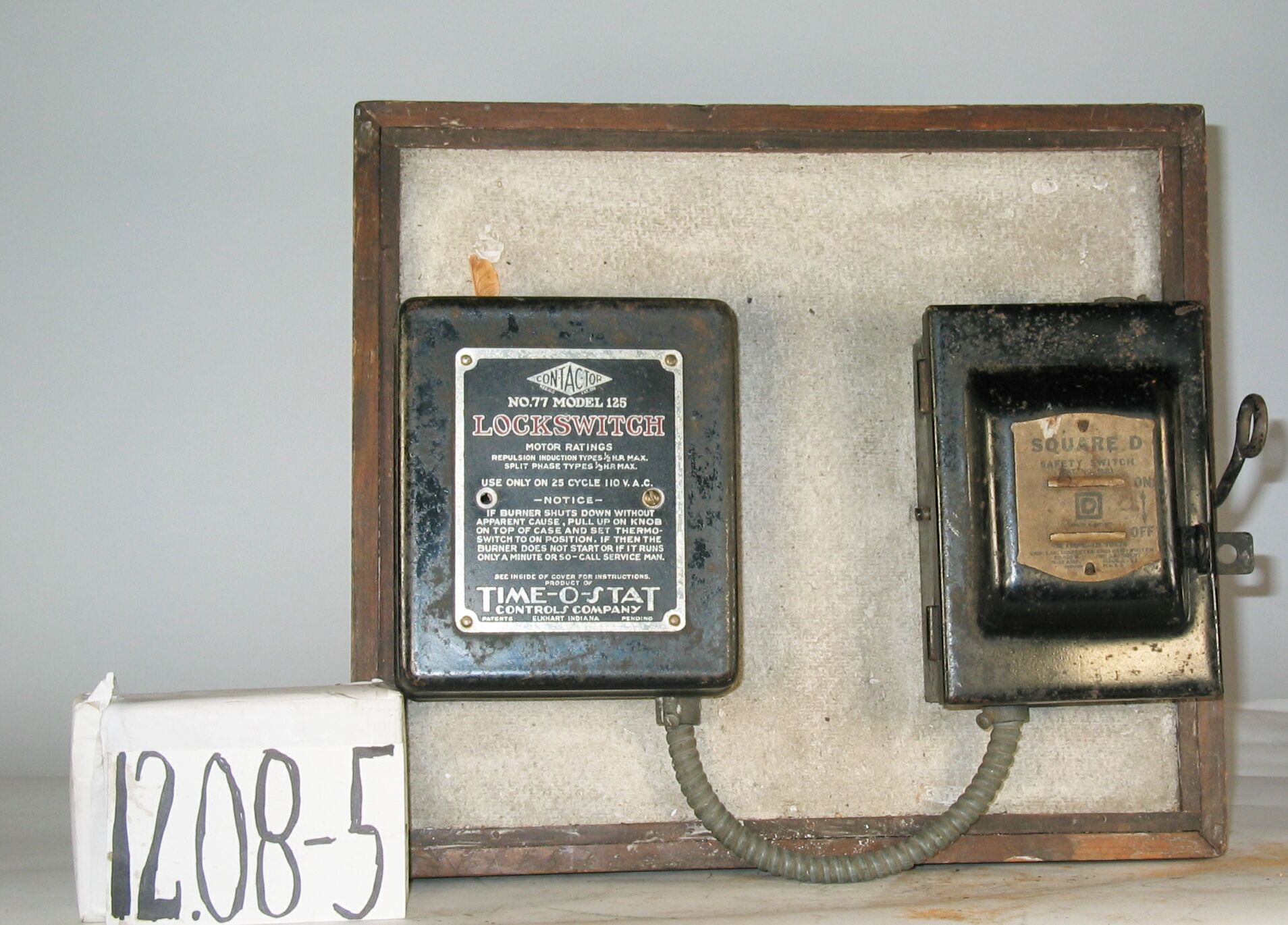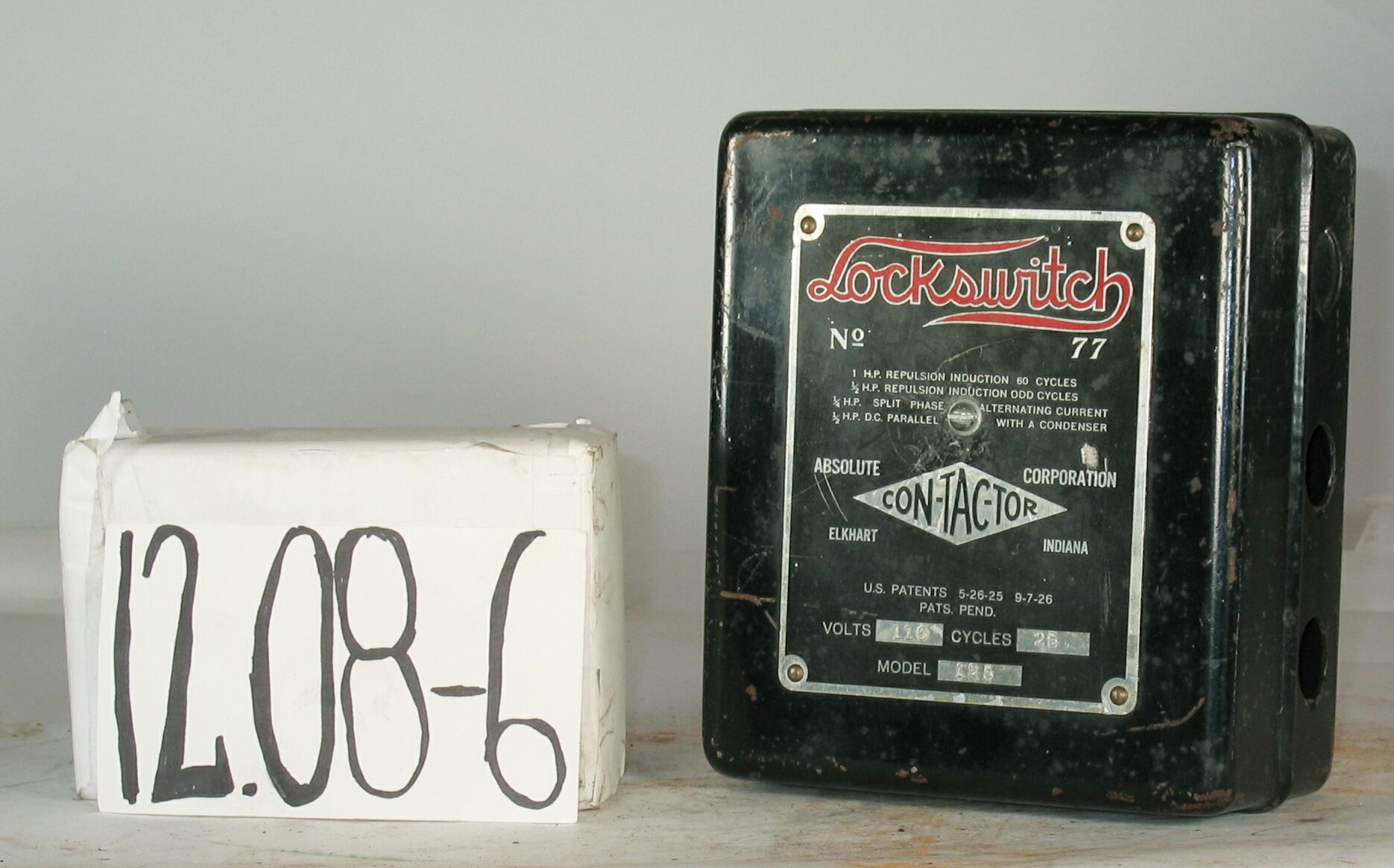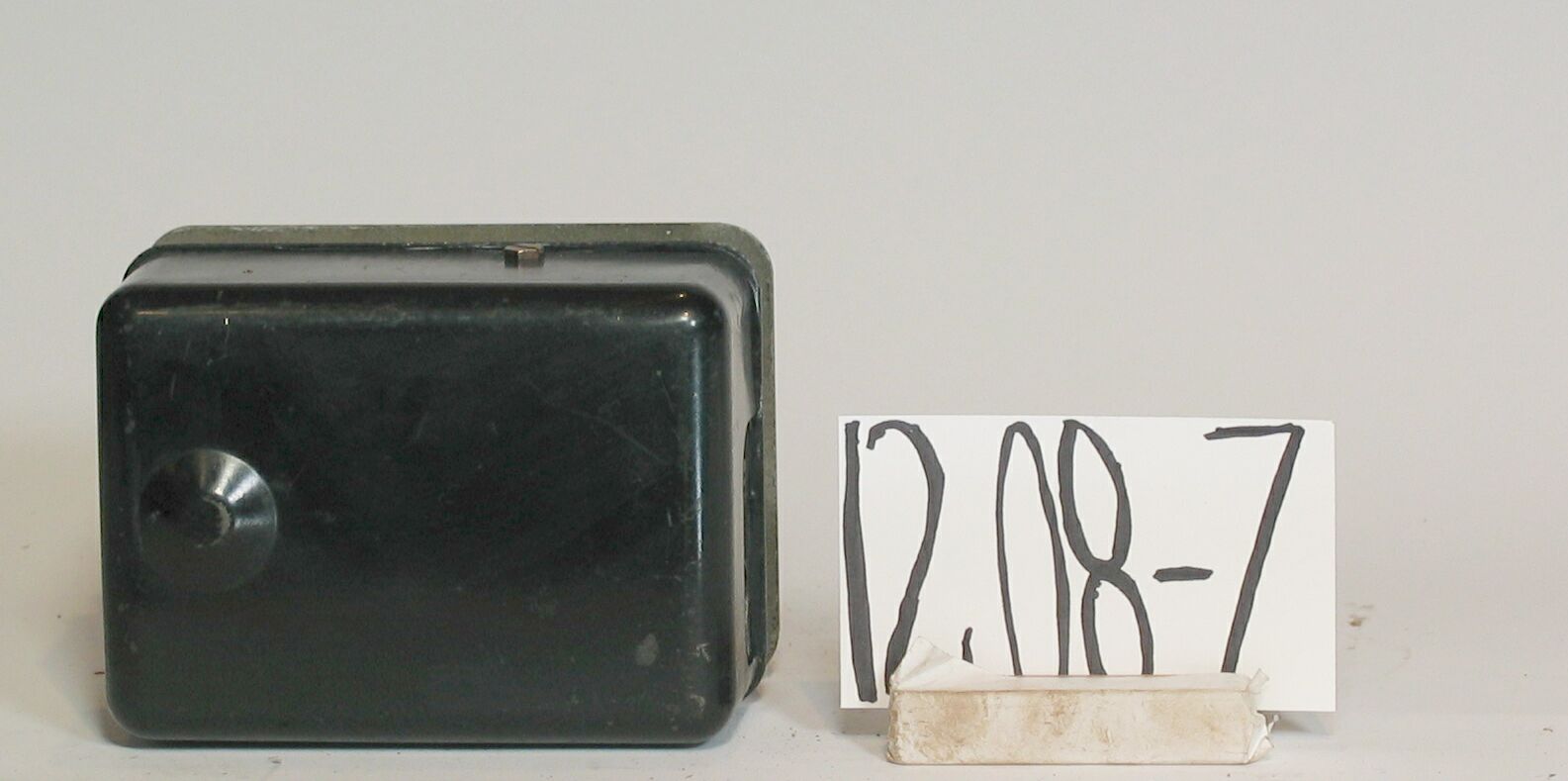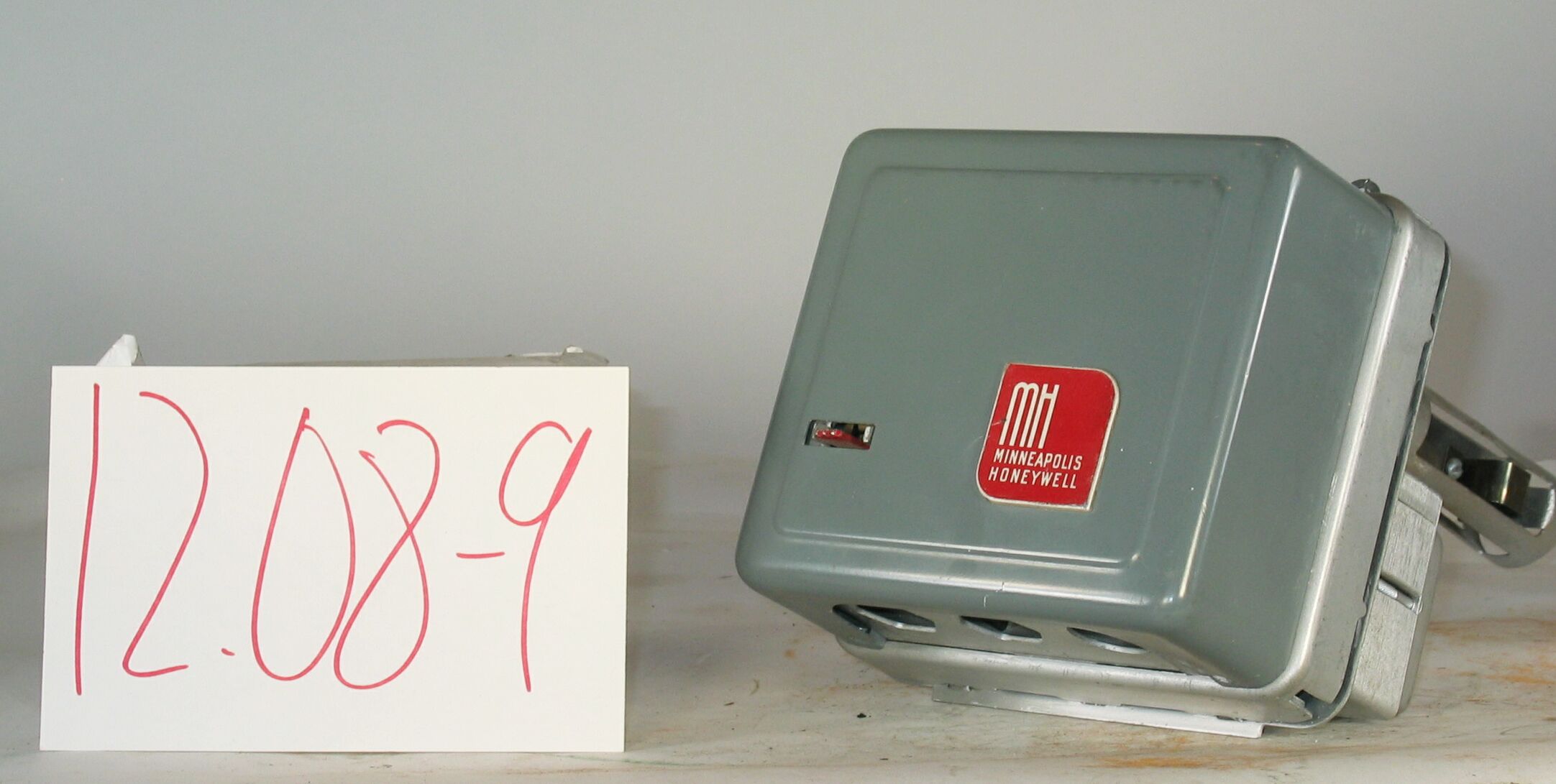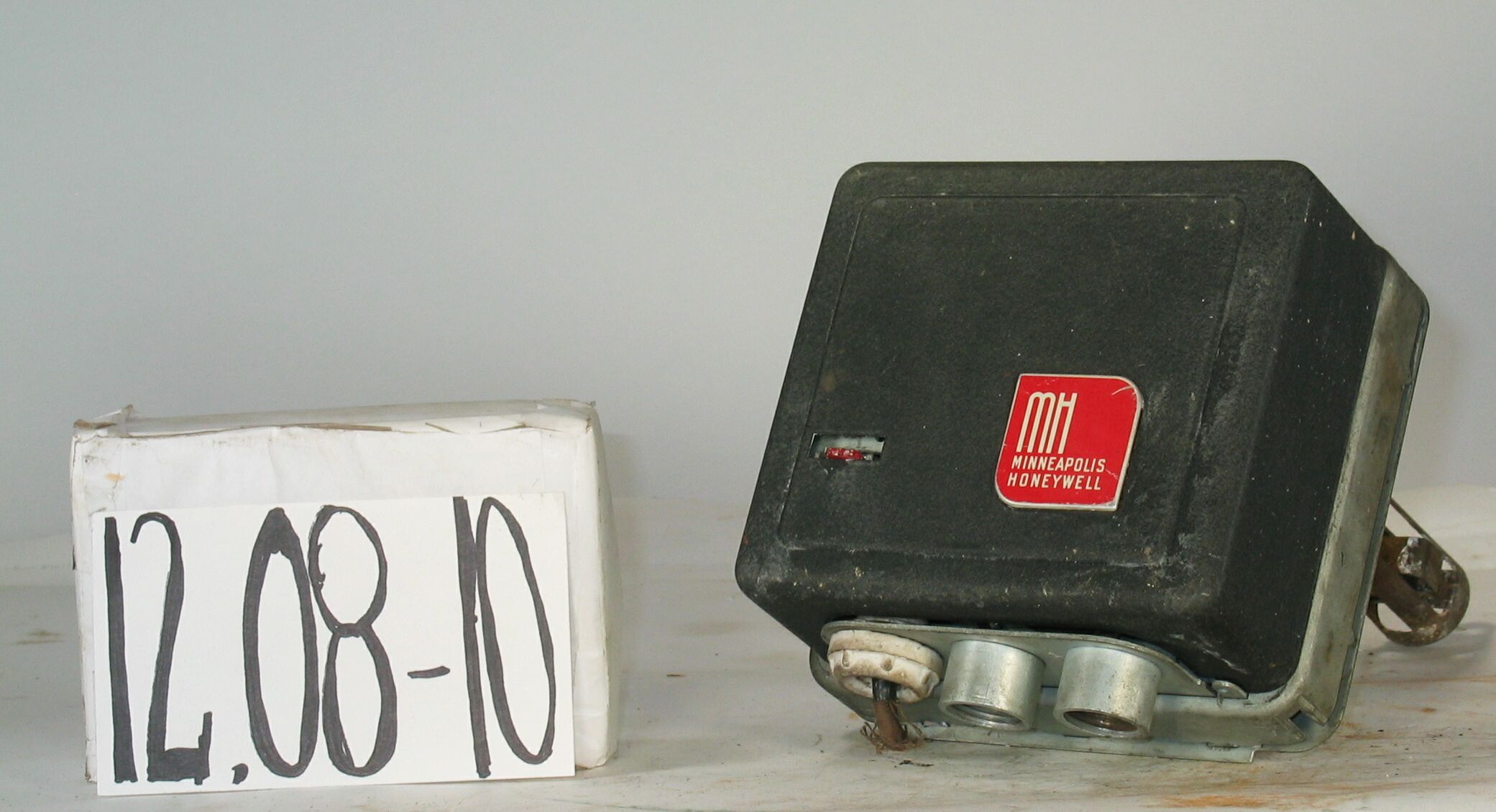12.08-11: Time-O-Stat Controls 1929 Flame Monitoring Device
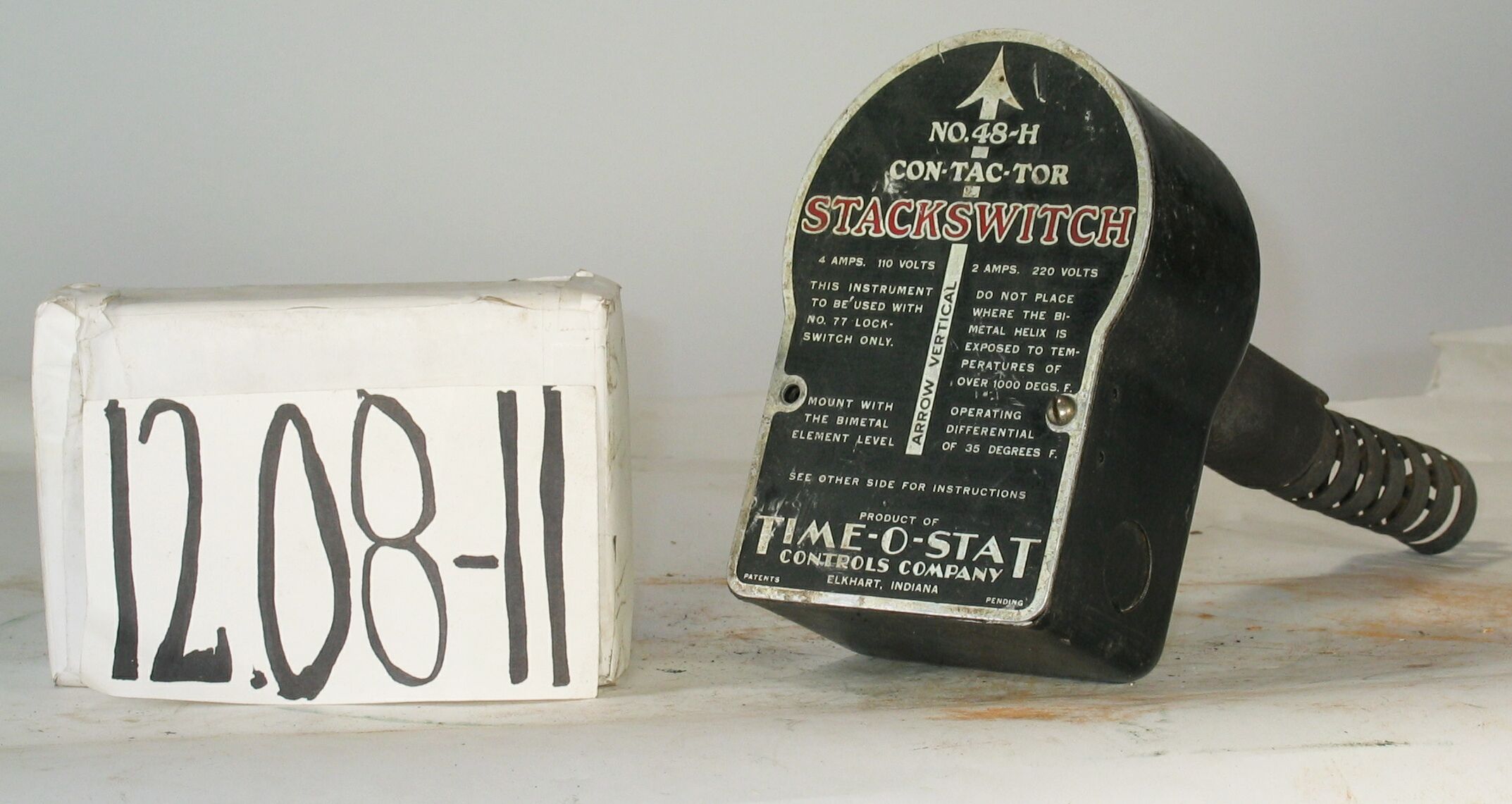
| HHCC Accession No. 2006.112 | HHCC Classification Code: 12.08-11 |
|---|
Description:
A 1920’s high tech, automated, flame monitoring device for oil fired, home heating systems. Paired with the manufacturer’s ‘Locksmith’ electromagnetic combustion controller [see ID#228], it operated using a helical bimetal spring to actuate twin mercury bulb switches, in order to control starting and running operations, ignition duration, flame failure and safety recycling time, Model 48H, Time-O-Stat Controls Co., Elkhart Ind. [I of 2, see ID# 229]
Group:
12.08 Pressure Atomizing Oil Burner Equipment and Systems - Fuel Flow and Combustion Controls
Make:
Time-O-Stat Controls
Manufacturer:
Time-O-Stat Controls Co., Elkhart Ind.
Model:
Model 48H
Serial No.:
Size:
4 x 12 x 6’ h
Weight:
5 lbs.
Circa:
1929
Rating:
Exhibit, education, and research quality, illustrating the engineering and design of early 20th century combustion controllers for automatic oil heating systems in Canada
Patent Date/Number:
See Note 1
Provenance:
From York County (York Region) Ontario, once a rich agricultural hinterlands, attracting early settlement in the last years of the 18th century. Located on the north slopes of the Oak Ridges Moraine, within 20 miles of Toronto, the County would also attract early ex-urban development, to be come a wealthy market place for the emerging household and consumer technologies of the early and mid 20th century.
This artifact was discovered in the 1950’s in the used stock of T. H. Oliver, Refrigeration and Electric Sales and Service, Aurora, Ontario, an early worker in the field of agricultural, industrial and consumer technology.
This particular control was used on a residential heating system in York County [York Region], North of Toronto during the 1930’s.
Type and Design:
Paired with the manufacturer’s ‘Locksmith’ electromagnetic combustion controller [see ID#228], Operates using a helical bimetal spring to actuate twin mercury bulb switches Controls starting and running operations, Ignition duration, Flame failure and Safety recycling time,
Construction:
Material:
Special Features:
Gloss black, pressed steel cabinet with built in electrical junction box Sophisticated name plate and logo in black, red and chrome Instructions stencilled to the inside of cover is a reminder of the complexity of the system, the dangers and risks of malpractice and the need for informed owners and operators
Accessories:
Capacities:
Performance Characteristics:
Operation:
Control and Regulation:
Targeted Market Segment:
Consumer Acceptance:
Merchandising:
Market Price:
Technological Significance:
The controller, with twin, tilting mercury bulb switches, stands as a marker of the period in the development of early line voltage automated, alternating current switching devices for inductive loads [electric motors]. Here the mercury tube became the preferred switching medium. The charred inside surface of the control cover shows the effect of an electrical fire at one point, not uncommon in early switching devices used on high starting current A.C. induction loads [electric motors]
With the ‘Locksmith’ system, and stack located heat monitor, compact and elegant in concept, design and construction the Absolute Con-Tac-Tor Corp., later Time-O-Stat Controls Co. would introduce a new generation of advanced engineered combustion safety controls [c.f., ID # 226 and 227] and take over acknowledged leadership in the field of automatic oil heating for the Canadian home. Absolute Con-Tac-Tor Corp, later Time-O-Stat Controls Co.moved to adopt an integrated systems approach, with its companion stack mounted heat sensor [ID # 229] and room thermostat [ID #215. The system stopped and started the oil burner, on call from the room thermostat, through a line voltage, electric solenoid actuated mercury bulb switch. New for the times, a compact thermally timed interlock, with manual reset performed the safety protection function. While simple, by contrast to the next generation of combustion controllers [See 234], these automated, electrical control devices were non-the-less something of a marvel, given the embryonic nature of engineering systems know-how of the times. These embryonic, electric automated systems were representative of the earliest introduction of complex systems into the Canadian home. See Note #2
Industrial Significance:
Absolute Con-Tac-Tor Corp., later Time-O-Stat Controls Co., would launch a new generation of combustion control and safety technology with their ‘Locksmith’ system. Compact and elegant in concept, design and construction it would prove to be the market leader. Later Time-O-Stat would be bought out by Honeywell to carry on in the position of widely acknowledged industry leader in HVACR automation and control Time-O-Stat Lockswitch and Stack Switch technology was widely used on both mechanical atomizing [See collection display item H2] and pressure atomizing [See collection display item H4] automatic oil heating systems in Canada throughout the early years of the industry. These control systems were a source of wonderment and no little fear for the Canadian public, as well as for many of the tradesmen who were called upon to understand, install and repair them, as well as to advise the homeowner on their proper, satisfactory operation. Absolute Con-Tac-Tor Corp., later Time-O-Stat Controls Co., would be among the first technology suppliers to the HVACR field, who understanding the increasing complexity of their automation technology, would provide service, installation and logic, trouble shooting guides.
Socio-economic Significance:
Socio-cultural Significance:
With combustion safety devices of increasing sophistication and reliability the public’s confidence and trust in automatic heating equipment would increase rapidly, or so it was hopped. It was a market of substantial size, but was dependent on the industry’s ability to deliver safe and reliable products at a price that Canadians of modest means could afford and believe in. A new Canadian culture of comfort and convenience had been triggered and was rapidly evolving in much of urban Canada, by the mid 1930’s, but only where the benefits of home electrification had arrived.
Donor:
G. Leslie Oliver, The T. H. Oliver HVACR Collection
HHCC Storage Location:
Tracking:
Bibliographic References:
Automatic Controls, Time-O-Stat Co. Elkhart Ind. , 1929 Installation and Service Manual, Time-O-Stat Controls, Elkhart Ind. , 1929
References Cybernetcs and General Systems [Oliver Collection]: Systems Engineering Tools, Harold Chestnut, 1966. Modern Systems Research for the Behavioral Scientist, Walter Buckley, Editor, Aldine, 1968. Systems Behaviour, John Beishon and Geoff Peters, Harper and Row, 1972 Systems Engineering Methods, Harold Chestnut, Wiley, 1977
Notes:
Canadian Patents: Canadian patents are shown in the company’s catalogue [Ref 1, page 46], dated 1925 and 1928
- The Introduction of Popular, Complex Systems into the Canadian Home:
The 1920’s saw the introduction of complex mechanical, electric and electronic systems into the Canadian home and the lives of many Canadians, most of them ill prepared. For the first time the public would experience, as an inherent part of their daily life’s routines, the benefits, as well as all too often the vagaries of systems engineering ‘ then in an embryonic state of development. The level of dependence on such systems, with all their inherent imperfections and attendant risks, would be no more apparent than in the field of automatic home heating.
These systems were at once intimidating, awe inspiring, often the source of feelings of personal ineptitude, as well as of fear for reasons of personal and property safety. Included in the early rush to popular technology systems were the automobile, the household radio and automatic home heating. But the most intimidating was, in many ways the latter, immensely obtrusive, in your face, larger than life, and all around you 24 hours a day, bringing with it a degree of dependency that the householder could not afford to forget in the dead of a Canadian winter. All three of these pieces of technology [the automobile, the household radio and the automatic home heating system], have in common an elaboration of interconnected and interdependent parts on which the integrity and performance of the system would be desperately dependent. For the automatic home heating system these components, each with its own unique integrity and operating characteristics, would include, for example: electric motors, flame sensors, solenoid valves, pressure sensors and actuators, electric ignition transformers, heat detecting devices and thermostats. The advent of such increasingly complex, automated systems [mechanical, electric, and electronic] would, in fact, by the late 1940’s lead to a new specialized field of study, known at that time as ‘Cybernetics’, and thence to the larger field of ‘general systems’. The focus was on coming to understand better the properties and performance of complex, inanimate systems, including their degree of purposefulness, self regulation and self direction setting, as well as their ability to communicate meaningful information within the network of which they were a part. For each component of the system must communicate effectively with others for the system to function safely and satisfactorily. System performance, stability, reliability and maintainability, among other criteria, were at stake. All of these criteria were of fundamental importance in the development of automated heating systems for the Canadian homeowner, and the inventors and manufacturers of the day knew it. [See References, General Systems] For their part the manufacturers of these systems, with their myriad component parts and complexities, would learn from the outset the importance of trained service people in communities across the country, wherever such systems would appear. By the 1940’s training courses were increasingly common, as well as control and systems handbooks and systems trouble shooting guides provided by equipment and systems manufacturers.
Related Reports:
CMX02 ‘ H9
